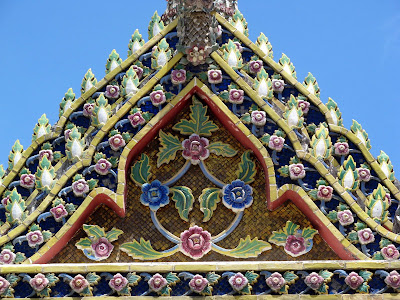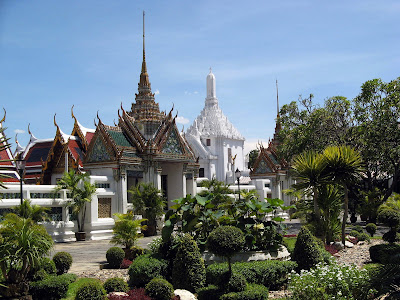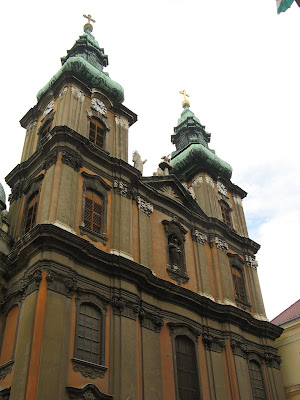
"We are recommending medical evacuation," explains my Peace Corps doctor? During my mid-service medical exam, several suspicious marks were found on my skin. The Peace Corps doctors suspected basal cell cancer - not the dangerous type, thankfully. They decided that the best course of treatment would be a visit to their medical back-up center in Bangkok.>

Bangkok was never on my "must see" list, but here I am being medically evacuated or as some light heartedly suggest going on a medical vacation or a "Medic-Vac."
I arrive at 4:00 am in the morning after a 9 1/2 hour flight from Kiev. I am anxious about new language and money conversion and getting a taxi especially at this hour in the morning. But as I step off the plane, I see that I can relax. I am in a very modern world class airport that is only a few years old. It is quickly becoming a hub for all of southeast Asia.
I am relieved that signs are in local Thai (a form of Sanskrit, I believe) and English. It is easy to navigate through customs and to the baggage claim. My final anxiety is also relieved. My back-pack comes circling around.
Outside I get a taxi. My driver speaks staccato. He only knows isolated words in English. Now I know how my beginner's Russian sounds to my Ukrainian friends. A word here and a word there, but not much of the connecting lingo.
I think he is talking about the recent unrest in Bangkok. He keeps making gun-shooting sounds like kids do when they are playing "shoot 'em." It's unnerving at 5:00 am especially when each "shoot 'em" sound is followed with laughter. I have to take several deep breathes to still my mind from racing ahead.
I need sleep.
After 20 minutes of a fast and thrilling ride, I reach the hotel. I am greeted by two doormen and a desk clerk who are all smiles. I mean these folks really know how to smile broadly. They greet you with palms together and a short bow too. I feel so welcomed.
My room is clean and simple like many 2 star hotels I have stayed in. I have all the basics and a comfortable bed.
I am bone tired.
The next day I see my doctor. The Bumrungard Medical Center is directly across the street from the hotel. The Peace Corps has made excellent arrangements even providing a specialized nurse to accompany me. She is great.
I enter a spacious lobby that resembles a 5 star hotel lobby. I see a Starbucks, a few shops and even a WIFI cyber corner amidst clusters of stylish sofas and comfy chairs. There is no institutional look here.
A young smiling Thai woman greets me in English. She directs me to the second floor registration. All is done efficiently, like America, and with even more friendly patient care.
My doctor is remarkable. He spends about 30 minutes examining and explaining treatment options. Several times he asks if I have questions and he does it in such a way as to invite questions. Can you believe it?
After a brief time in the waiting area where containers of juice and water are offered, I return for treatment. The doctor spends another 20 minutes taking a few biopsies and doing some skin freezing to prevent further problems.
I am delighted with the care. Procedures are in keeping with what I know of American practices and I never got the feeling that he was in a hurry to see another patient. In fact, he gives me a restaurant recommendations and even draws a detailed map on how to get there.
The next day is for sightseeing. I want to go to the Grand Palace and Wat Phara Kaew, a temple complex where the revered Emerald Buddha resides. Getting there is a challenge.
I study maps and metro stations. The streets in Bangkok seem like a jumble of pick-up sticks. As best as I can tell, each neighborhood has a main avenue with smaller streets that run off of it and then smaller allies that run off the streets. The streets in each area are numbered. The odd numbers run off of one side of the main avenue and the even on the other. It is quite tricky for a westerner to figure out. Missing is the predictable grid pattern.
I venture off to the Sky Way, an elevated Metro that has been in operation for a few years. Bangkok is notorious for constant grid lock. The Sky Way speeds you to your destination in a clean modern system. Stops are announced in Thai and English. I am impressed.
Unfortunately, the public transit only takes me 3/4 of the way. Now I must catch a taxi. My driver speaks no English and has difficulty understanding my map which of course is in English script.
It's a struggle or as I prefer to think during my better moments, a new adventure. Somehow after 20 minutes of traffic jams and making a wrong turn, we get to the Grand Palace and Buddha Temple. I have no complaint. The driver smiles and gives me a discount for the wrong turn.
The vacation part of my "Medi-Vac" begins.






































